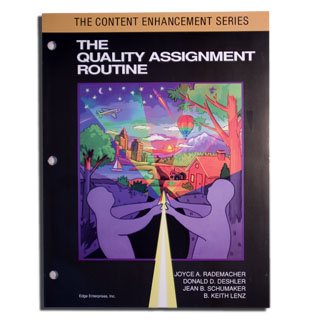
Publication Info: Edge Enterprises, 1998
Quality Assignment Routine Resources:
VIDEO
PPTs
MORE
- Access Florida SPDG LiveBinder Assets (Key: CE QAR)
- Access Content Enhancement Routine Checklists
- Description of the Quality Assignment Routine from the SIM website
MICROCREDENTIALS
Strategram/Stratenotes
- Strategram Vol 6, No. 4 April, 1994: A Quality Assignment Routine - Planning High Quality Assignments
- Strategram Vol 6, No. 5 June 1994: Quality Assignment Routine Part 2: Explaining and Evaluating High Quality Assignments
Assets from FLORIDA SPDG Livebinders:
Teacher can access Florida Live Binder assets. Share this link and password:
https://www.livebinders.com/play/play_shared_binder/2201526?play_view=play Password CE QAR
- Cue Do Review
-
The overall instructional process that guides use of the CE device with the Routine’s Linking Steps. This instructional process involves:
Cue: teacher announces the CE routine and explains its use, how it will help students and expectations for student participation
Do: teacher and class collaboratively construct the device using the Linking Steps that “connect” the content to the needs and goals of students
Review: Information presented in the device is reviewed and confirmed, use of the device is reviewed and confirmed, use of the device as a learning and study tool is modeled
- The Routine
- Device Templates
- Device Checklist
- Examples
- REACT Strategy Cue Card
- PACE Cue Card
- PLAN Chart Guidance for Teacher
Research
- Quality Assignment Routine Research slide
- Lenz, B.K., Bulgren, J.A., & Hudson, P. (1990). Content enhancement: A model for promoting the acquisition of content by individuals with learning disabilities. In T.E. Scruggs & B.Y.L. Wong (Eds.), Intervention research in learning disabilities (pp. 122-165). New York: Springer-Verlag. This book chapter discusses information processing and pedagogy for students with learning disabilities, including suggestions for teacher planning and teaching routines such as the Chapter Survey Routine, Concept Teaching Routine, and Assignment Completion Routine.
- Rademacher, J.A. (1999). Enhancing assignment completion for academically diverse learners. In D.D. Deshler, J.B. Schumaker, K.R. Harris, & S. Graham (Eds.), Teaching every adolescent every day: Learning in diverse middle and high school classrooms (pp. 146-206). Cambridge, MA: Brookline Books. This book chapter discusses the planning of high-quality assignments, improving the nature of secondary assignments to students, presenting assignments with students, and technology as a tool for enhancing assignment completion.
- Rademacher, J.A. (2000). Involving students in assignment evaluation. Intervention in School and Clinic, 35(3), 151-156. This article describes the relationships among the planning, presenting, and evaluating components of the assignment completion process, then provides guidelines for using the Quality Assignment Routine's PACE 1,2,... self-checking process.
- Rademacher, J.A., Schumaker, J.B., & Deshler, D.D. (1996). Development and validation of a classroom assignment routine for inclusive settings. Learning Disability Quarterly, 19(3), 163-178. Multiple-probe and comparison-group designs are used in combination to (a) identify and explore high-quality classroom assignments from the perspective of inclusion teachers and students (LD and non-LD) and (b) determine the effects of the Quality Assignment Completion Routine on content teachers' planning, explanation, and evaluation of assignments.
- Rademacher, J., Tyler-Wood, T., Doclar, J., & Pemberton, J. (2001). Developing learner-centered technology assignments with student teachers. Journal of Computing in Teacher Education, 17(3), 18-25. This article describes a project in which technology experts worked with university faculty and student teachers to infuse technology into high-quality assignments incorporating aspects of the Quality Assignment Routine.
